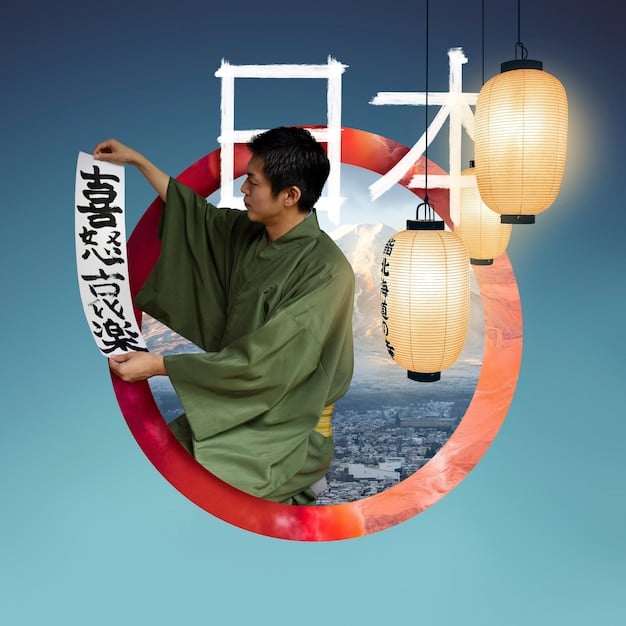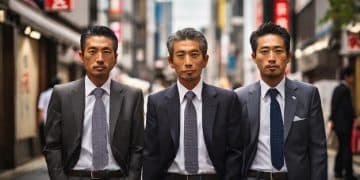J-Drama Remakes: US Adaptations Worth Watching? Critical Analysis

When evaluating the watchability of US adaptations of J-Dramas, it’s essential to consider how well they balance preserving the original’s cultural nuances with appealing to a Western audience, often leading to mixed results that range from faithful homages to entirely reimagined narratives.
The landscape of television has become increasingly globalized, with international hits frequently inspiring local adaptations. Among these, J-Drama Remakes: Are the US Adaptations Worth Watching? A Critical Analysis delves into a particularly fascinating subset: Japanese drama series re-imagined for American audiences. This article explores the delicate balance between cultural preservation and adaptation, evaluating whether these US versions successfully capture the essence of their Japanese predecessors while resonating with a new demographic.
The cultural bridge: understanding the appeal of J-Dramas
The enduring popularity of J-Dramas stems from their distinctive storytelling, often characterized by nuanced character development, profound emotional depth, and unique cultural contexts. Unlike many Western productions that emphasize dramatic plot twists, J-Dramas frequently delve into the minutiae of human relationships, personal growth, and societal pressures, offering a refreshing narrative approach. This focus on introspection and subtle emotional exploration is what often draws international viewers, creating a dedicated fanbase eager for more. These original series often provide a window into Japanese society, traditions, and values, which can be both an educational and deeply moving experience for global audiences. The themes explored frequently touch on universal human experiences such but always framed within specific cultural lenses that make them distinctly Japanese, enriching the viewer’s perspective.
Unique storytelling elements
Japanese dramas excel in crafting compelling narratives that often avoid rapid plot escalation, preferring a slow-burn approach. This allows for meticulous development of characters and their internal struggles, fostering a deep connection with the audience. The emotional impact is often delivered through understated performances and symbolic imagery, a stark contrast to the more overt expressions common in Western television. This storytelling style captivates viewers who appreciate nuance and are willing to invest in character journeys rather than just plot resolutions. Many J-Dramas are adaptations of manga or novels, which brings with it a pre-existing fan base and a rich source material that can be explored in depth.
- Emotional depth: Focus on inner conflicts and relationship dynamics.
- Cultural context: Insights into Japanese societal norms and traditions.
- Pacing: Slower, more deliberate narrative progression.
- Understated performances: Emotions conveyed subtly, often through gestures or expressions.
J-Dramas also frequently explore genres that are less common in US television. For example, workplace dramas often blend humor with serious commentary on corporate culture, while slice-of-life series find profound meaning in everyday occurrences. This variety contributes to their global appeal, offering something different from standard Western fare. The blend of everyday realism with moments of fantastical escapism is a hallmark of many successful J-Dramas, allowing for a broader emotional spectrum within a single series. This unique blend contributes to their continued success both domestically and internationally, making them prime candidates for adaptation though also complex challenges.
Translating narratives: challenges and triumphs in adaptation
Adapting a J-Drama for a US audience is a complex undertaking, fraught with challenges but also offering significant opportunities for creative success. The core difficulty lies in preserving the essence of the original story while making it accessible and relatable to a different cultural demographic. This often involves navigating differences in humor, social norms, and narrative conventions. A direct translation rarely works; instead, successful adaptations find a way to reinterpret themes and characters within a new cultural framework. The triumphs occur when the remake manages to capture the spirit of the original without simply copying it, forging its own identity while honoring its source.
Cultural nuances and humor
One of the most significant hurdles in adapting J-Dramas is translating cultural nuances and humor. What might be perceived as funny or emotionally poignant in Japan might simply not land the same way in the US, or worse, could be misinterpreted. Jokes often rely on specific social contexts or linguistic subtleties that are difficult to transfer. Adaptations must either reconstruct these elements or replace them with culturally equivalent counterparts that resonate with American viewers. This process requires a deep understanding of both cultures to ensure that the remake doesn’t feel disjointed or inauthentic to its new audience.
For example, the subtle comedic timing and situational humor prevalent in many Japanese series often rely on cultural expectations around deference, social hierarchy, and indirect communication. These elements, if not thoughtfully adapted, can lose their comedic bite or even be missed entirely by a Western audience less familiar with these social dynamics. The challenge for US adaptors is to find analogous situations or comedic structures that elicit a similar response without losing the original’s charm. This is why many US remakes sometimes lean into broader, more overt comedic styles.
Narrative structure and pacing
J-Dramas frequently employ a narrative pace that is slower and more contemplative compared to the often fast-paced, high-stakes storytelling typical of American television. Where a Japanese series might take several episodes to explore a character’s internal conflict, a US remake may feel pressured to accelerate these developments to maintain viewer engagement in a different media landscape. This shift in pacing can sometimes result in a loss of the original’s emotional depth and meticulous character building. When adaptations rush these critical elements, they risk superficiality.
Conversely, some US adaptations have successfully maintained a more measured pace, betting on the strength of the original narrative structure to carry over. These remakes often highlight that compelling storytelling transcends cultural boundaries if executed well. The key is in understanding which narrative beats are essential to the story’s core and how they can be effectively re-contextualized. Ultimately, the success of an adaptation often hinges on its ability to respect the original’s tempo while still feeling natural to its target audience.

Case studies: comparing notable J-Drama remakes
Examining specific J-Drama remakes offers concrete examples of how these adaptations fare. Some have achieved critical acclaim and commercial success, demonstrating a masterful understanding of cross-cultural storytelling. Others have fallen short, revealing the pitfalls of superficial adaptation or a failure to grasp the original’s core appeal. By looking at both successes and missteps, we can glean valuable insights into what makes a US adaptation of a J-Drama truly worth watching. This comparative analysis helps to highlight the varying approaches taken by producers aiming to capture the magic of their Japanese counterparts.
“The Good Doctor” (original: “Good Doctor”)
The US adaptation of “The Good Doctor” stands out as a significant commercial success, demonstrating how a J-Drama’s premise can be effectively translated for a global audience. The original Japanese series, itself an adaptation of a Korean drama, focused on a prodigious autistic surgeon navigating the complexities of a hospital environment. The American version retained this core concept but infused it with character dynamics and medical ethics discussions that resonated strongly with Western viewers. The success lay in its ability to universalize the themes of empathy, prejudice, and the pursuit of excellence, making Dr. Shaun Murphy’s journey compelling across cultures.
The remake’s strength lies in its meticulous character development and its willingness to tackle challenging social issues without losing sight of its uplifting message. While the original J-Drama focused heavily on the cultural nuances of the Japanese medical system and societal views on autism, the US version broadened its scope to explore these themes from an American perspective, often leading to different yet equally impactful dramatic resolutions. This adaptation serves as a prime example of retaining the spirit of the original while allowing the story to evolve naturally within a new cultural setting.
“Midnight Diner” (original: “Shinya Shokudo”)
“Midnight Diner” provides an interesting case study, as its US adaptation, “Midnight Diner: Tokyo Stories,” is less a remake and more an expansion and re-contextualization for Netflix’s global audience. The original J-Drama is beloved for its gentle, episodic storytelling centered around a small, late-night diner in Tokyo and its diverse clientele. The US adaptation maintains this format, keeping the setting in Tokyo but introducing new stories and characters alongside familiar elements. This approach allowed the US version to tap into the existing charm of the original without attempting to replicate it entirely.
Instead of a complete overhaul, “Midnight Diner: Tokyo Stories” embraces the original’s unique atmosphere and quiet profundity. It subtly weaves in aspects that appeal to international viewers, such as the exploration of different cuisines and human connections, while still offering an authentic glimpse into Japanese culture. This non-traditional adaptation demonstrates that sometimes, the best way to “remake” a J-Drama is to continue its narrative in a way that respects its origins while inviting a broader audience into its world. It champions the idea that some stories don’t need radical transformation to travel well.
“Kamen Rider Dragon Knight” (original: “Kamen Rider Ryuki”)
The adaptation of “Kamen Rider Ryuki” into “Kamen Rider Dragon Knight” for US audiences represents a more traditional, and at times, more challenging attempt at cross-cultural adaptation from a tokusatsu J-Drama. While “Kamen Rider” is an iconic franchise in Japan, its distinct style and narrative tropes often require significant modification for Western tastes. The US version largely retained the core premise of battling riders in an alternate reality but altered character motivations, streamlined complex plotlines, and adjusted the tone to fit American children’s television standards.
This remake faced the difficult task of balancing the original’s darker themes and moral ambiguities with the need for a more straightforward heroic narrative suitable for its target demographic. While it introduced the “Kamen Rider” concept to a new generation of American viewers, it often simplified the intricate character relationships and existential questions that made “Ryuki” so compelling. The mixed reception of “Dragon Knight” highlights the tightrope walk involved in adapting highly stylized and culturally specific genre content for a fundamentally different audience, demonstrating that some narratives are harder to transplant without losing their essential flavor.
What makes a J-Drama remake truly successful?
The definition of a “successful” J-Drama remake is multi-faceted, encompassing critical reception, audience engagement, and its ability to honor the source material while forging its own identity. A truly successful adaptation doesn’t just translate a story; it transposes its spirit, emotions, and thematic core into a new cultural context seamlessly. This requires a deep understanding of both the original work and the target audience, going beyond superficial changes to achieve a genuine emotional and narrative connection. Success is not merely about ratings, but about creating something that stands on its own merits as well as a tribute to its origins.
Fidelity versus reinvention
The tension between fidelity to the original J-Drama and the need for reinvention is often at the heart of an adaptation’s success or failure. Overly faithful remakes can feel disjointed or bland if they don’t account for cultural differences, whereas radical reinventions risk alienating fans of the original. The most successful adaptations find a sweet spot, retaining the core narrative, character arcs, and thematic integrity, while skillfully reinterpreting elements like dialogue, humor, and specific cultural contexts. This careful balance allows the remake to feel fresh and relevant to its new audience without betraying the source material’s essence.
It’s about understanding which elements are universal and which are culturally specific. For instance, themes of love, loss, ambition, and redemption are universal, but the ways these themes are expressed and resolved can vary wildly between cultures. A smart adaptation identifies these universal truths and then re-contextualizes their expressions to resonate locally. This nuanced approach ensures that the remake isn’t just a copy, but an organic growth from the original seed, offering a familiar yet uniquely tailored experience.
Casting and performances
The casting choices and performances in a J-Drama remake are paramount to its success. Actors must not only embody the characters but also bring them to life in a way that feels authentic to the new cultural setting, sometimes requiring them to portray nuances that differ from the original Japanese performances. A strong ensemble cast can elevate even a mediocre script, while miscast actors can sink an otherwise promising adaptation. The ability of the actors to deliver nuanced performances that convey the intended emotions and motivations, within the adapted context, is crucial for audience buy-in. Their performances must connect with the audience on an emotional level.
Furthermore, the chemistry between cast members is often a critical factor, particularly in character-driven dramas that rely heavily on interpersonal relationships. If an adaptation fails to establish believable and compelling relationships, it struggles to convey the emotional depth that often defines J-Dramas. Therefore, brilliant casting, combined with superb acting that respects the source material while bringing a fresh perspective, plays a huge role in determining if a US adaptation is ultimately worth watching. The actors are the conduits for the story, and their ability to convey its heart is invaluable.
Audience reception: critical acclaim versus fan expectations
Audience reception for J-Drama remakes is often a tightrope walk between critical acclaim and the passionate expectations of original fans. While critics may praise an adaptation for its unique take or artistic merits, loyal fans of the J-Drama might find even minor deviations from the source material to be unforgivable. This dichotomy highlights the intense scrutiny these remakes face, especially in an era of global fandom where viewers have easy access to both versions. Navigating these varied expectations is a significant challenge for creators. Ultimately, a truly worthwhile adaptation manages to satisfy both camps.
Pleasing both new and old audiences
The ultimate goal for any J-Drama remake is to capture the hearts of new viewers while also appeasing the existing fanbase of the original. This is a delicate balancing act. New audiences often judge the series purely on its own merits, without the baggage of comparison, seeking a compelling story and relatable characters. Original fans, however, bring a deep emotional investment in the source material, often scrutinizing every plot point, characterization, and stylistic choice against their beloved original.
A successful remake understands this dynamic and creates an experience that offers something fresh and engaging for newcomers, while still paying homage to the spirit, key moments, and emotional core that resonated with original fans. This might involve subtle nods, faithful recreations of iconic scenes, or a commitment to preserving the core themes. When an adaptation manages to strike this balance, it not only expands the story’s reach but also validates the enduring appeal of the original J-Drama, demonstrating its universal resonance.
The impact of online communities
Online communities and social media play a significant role in shaping the perception of J-Drama remakes. Fan forums, review sites, and social platforms become arenas for intense discussion and debate, where praises for clever adaptations mingle with criticisms for perceived missteps. The immediate and widespread feedback from these communities can significantly influence the public’s perception of a remake’s success or failure. These platforms amplify both positive and negative sentiments, making it crucial for adaptations to foster genuine engagement.
This digital landscape means that adaptations are not judged in a vacuum. Creators are often aware of the strong opinions held by fan communities and sometimes even incorporate feedback or adjust future episodes based on these discussions. The impact of online communities underscores the interconnectedness of global entertainment, where a well-loved J-Drama remake can spark new interest in the original, creating a virtuous cycle of appreciation across international borders.
The future of J-Drama remakes in the US
The future of J-Drama remakes in the US appears to be a continually evolving landscape, driven by the increasing demand for diverse storytelling and the proven success of past adaptations. As global content consumption rises, American production companies are likely to continue looking abroad for compelling narratives that can be reinterpreted for domestic audiences. The key will be in learning from previous experiences, understanding the nuances of cross-cultural adaptation, and prioritizing authentic storytelling over mere replication. The trend suggests a move towards more thoughtful and respectful adaptations.
Expect to see a continued exploration of different genres, from romantic comedies and slice-of-life dramas to thrillers and medical procedurals. The emphasis will probably shift from direct remakes to “inspired by” series, which take the core concept or theme of a J-Drama and build an entirely new narrative around it, giving creators more creative freedom while still leveraging the proven appeal of the original idea. This approach could lead to more innovative and successful US adaptations in the years to come, further bridging the gap between Eastern and Western narratives.

| Key Aspect | Brief Description |
|---|---|
| 🎭 Cultural Translation | The primary challenge is adapting Japanese cultural nuances and humor for US audiences without losing original meaning. |
| ⏱️ Pacing & Narrative | US remakes often adjust J-Drama’s slower pacing for faster Western narrative conventions. |
| 🌟 Success Factors | Successful adaptations balance fidelity to the original with creative reinvention and strong casting. |
| 📈 Future Trends | Expect more “inspired by” concepts, focusing on universal themes with diverse genre exploration. |
Frequently asked questions about J-Drama remakes
J-Dramas are adapted to leverage proven storytelling concepts, unique premises, and strong character development that have already resonated with an audience. US producers aim to make these successful narratives accessible to a broader English-speaking demographic, often seeking to replicate their original popularity while introducing new cultural perspectives and production values. It’s a way to tap into diverse and compelling stories that have global appeal.
No, US adaptations rarely stay 100% true to the original J-Drama. While they often retain the core premise and key character arcs, significant changes are frequently made to suit American cultural tastes, narrative pacing, and humor. This can involve altering plot points, character motivations, and even the overall tone to ensure resonance with the target audience. The level of fidelity varies greatly from one remake to another.
Some of the most critically and commercially successful US adaptations include “The Good Doctor” (based on “Good Doctor”), which captured widespread audience appreciation with its compelling medical drama. “Midnight Diner: Tokyo Stories” (based on “Shinya Shokudo”) is also well-regarded for maintaining the original’s charm while expanding its narrative for a global platform. These adaptations effectively balanced cultural translation with captivating storytelling.
US producers face several challenges, including translating intricate cultural nuances and humor, adapting the often slower narrative pacing of J-Dramas to fit faster Western television conventions, and managing the expectations of both new audiences and loyal fans of the original. Successfully navigating these issues requires a deep understanding of both Japanese and American cultural contexts, careful casting, and thoughtful script development. It’s a complex process to get right.
Whether J-Drama remakes are “better” than their originals is subjective and depends entirely on individual viewer preference. Some prefer the original for its authentic cultural context and storytelling, while others might connect more with the adapted versions due to familiarity with American cultural norms and actors. Both versions typically offer unique strengths and provide different viewing experiences. It’s often recommended to watch both to form an informed opinion.
Conclusion
The critical analysis of J-Drama remakes for US audiences reveals a landscape of varied success, where the act of adaptation is a delicate balance between honoring source material and appealing to a new cultural context. While some remakes master this equilibrium, delivering compelling narratives that stand on their own merit, others falter by losing the essence of what made the original so captivating. Ultimately, whether US adaptations are worth watching hinges on their ability to thoughtfully translate cultural nuances, adapt narrative pacing, and deliver strong performances that resonate with both new and existing fanbases. The future promises continued evolution, with a growing emphasis on “inspired by” concepts that leverage proven storytelling while fostering creative reinvention.





